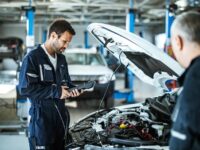The importance of rubber seals in your classic car

If you own a classic car or are currently renovating one, you’ll understand how important rubber seals are. While the engine might need tuning and the bodywork repaired to get your car out on the road, rubber seals can be particularly vulnerable to age and damage.
Replacing them is critical if you want to reduce leaks and cut down wind noise or prevent damage to your vehicle. Of course, a lot depends on the type of classic car you have and its age. Rubber seals, however, are universal.
Where do you find rubber seals in a classic car?
Like most vehicles, the main place you’ll find rubber seals in a vintage vehicle is around the windows and perhaps on the roof if you have a retractable top fitted there. In these places, rubber seals are used to provide a flexible, airtight join and are usually made from malleable rubber that is easy to fit and durable over the long term.
You’ll also find smaller seals in and around the engine, for example, preventing oil leaks and keeping certain sections of your classic car isolated. Some of these will be visible, others are hidden in the workings of the engine.
Stopping water leakage and fix windows
Classic cars are not as tightly sealed as modern ones and even a small amount of damage in a seal can cause leaks and prevent windows opening and closing properly. Constant leaking water due to a damaged rubber seal will eventually get into the cars infrastructure, causing rust to develop and other problems.
A badly fitted seal is likely to affect door and window operation and that can cause problems with safety as well as comfort. Most classic cars have wind up windows which can make operation difficult.
Why wind noise is a problem with some classic cars?
If you’ve ever driven a classic car and had to cope with the noise of the wind rushing by, you’re not alone. Damaged seals can make your pride and joy one of the noisiest places to sit and really have a significant negative impact on your driving experience.
Rubber seals on the engine
Gaskets and oil seals are vital to helping maintain the integrity of your engine. If these are damaged it could mean leaks and faults in the motoroccur over time. That means they need to be replaced as a matter of urgency.
Unless you are a mechanic, this is generally something that you should leave to the professionals, particularly if you don’t want to damage your classic car.
When to replace rubber seals on your classic car
It’s important to check the rubber seals on your car at regular intervals and change them if they are starting to degrade. If you are renovating or repairing a classic vehicle we suggest you do this at the same time as you do all that work to avoid any problems later on.
Generally, we don’t notice that there is something wrong with the seals in our car until something goes wrong. You might notice that the wind is whistling a little louder, the window takes effort to wind down, you’re getting drops of rain on your coat as you drive along or your engine is starting to struggle.
It’s a good idea to get into the practice of having all your rubber seals checked when you take your classic car in for an MOT and service. That should set you up for the next 12 months and ensure you have a comfortable drive at all times.







